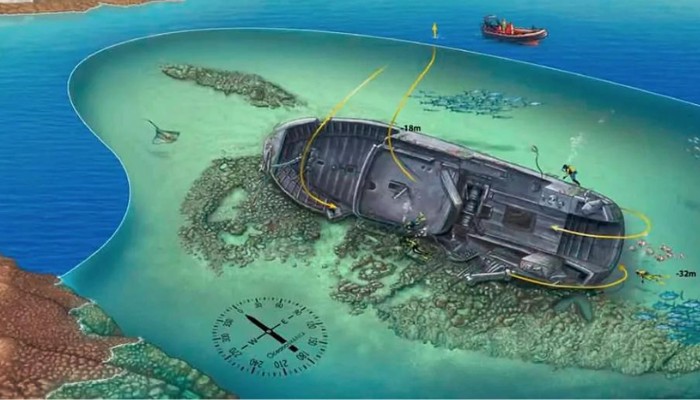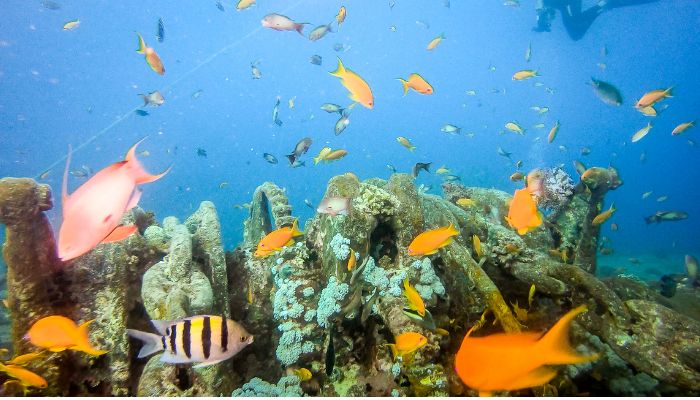
Wreck Diving - Where and How to do it?
Wreck diving is the best plan to unravel the most interesting mysteries and stories that have rested on the seabed for decades.
Moreover, it is an epic experience that you should definitely live if you are an adventurous diver eager to have fantastic encounters with the friendliest and most curious marine species that have found a home on these vessels of yesteryear.
But what exactly does wreck diving have in store for you, what to look out for and where can you start your underwater journey?
To all this we will answer in this post Join us!
What are Wrecks and why are they so Important?
Shipwrecks are much more than just sunken ships resting on the seabed. They are iconic pieces that encapsulate millenary stories beneath the waves.
These fascinating underwater relics are considered true treasures for lovers of marine life and adventure. Each wreck tells a unique story, from ancient galleons that sailed laden with riches to modern warships that witnessed epic battles.
Daring to unravel the mysteries of these shipwrecks allows us to take a trip back in time and connect with history. But that's not all! They also offer a sanctuary for marine life to thrive for decades, while awakening our adventurous spirit on every dive.
And there's even more. In the following sections you will find out what types of wrecks you can dive, where to find them and how you can prepare for the dive.
What Types of Sunken Ships Can You Dive On?
Wrecks can be classified into different categories according to their period, purpose and characteristics. Among the most common types of wrecks you can venture into are:
- The mighty galleons: These majestic ships were vessels of war or treasure transport used by the great maritime powers during the past centuries. Once inside, you will unravel history from its epicenter and take a journey to remote times full of epic feats and conflicts.
- Cargo Ships: From merchant ships to barges, these vessels transported goods and supplies between different ports, contributing to global trade and expansion during challenging decades.
- Military Ships: Warships, such as battleships and submarines, have been protagonists in war conflicts and, on occasions, have met their fate at the bottom of the sea after historic battles.
- Fishing boats: These are vessels used for fishing, from small boats to large trawlers, which can also become wrecks and offer a refuge for marine life. In them you can see a wide diversity of species that will make your trip even more special.
Why Scuba Diving on Sunken Ships?
Shipwrecks are not only a window to the past, but also play a crucial role in the preservation of marine life and ecological balance. Over time, these shipwrecks become artificial reefs, providing a safe habitat for a wide variety of marine species.
In addition, the remains of these ancient ships offer underwater archaeologists a unique opportunity to unravel the history of navigation, trade and warfare.
Each wreck find is like another piece in a historical puzzle, allowing us to reconstruct the past and better understand how our lives are intricately intertwined with the oceans.
But the story doesn't stop there.
Wrecks also play a relevant role in sustainable tourism, as they attract divers from all over the world who wish to experience the thrill of discovering submerged history.
However, it is important to highlight the need to dive with responsibility and respect towards these historical sites and vulnerable ecosystems, making sure not to cause damage and to preserve them for future generations. We will tell you more about this later.
Best Wrecks in Lanzarote for Scuba Diving
In Lanzarote we can explore a few sunken ships full of mysteries and adventures.
From Puerto del Carmen to Arrecife, you will be able to dive in wrecks full of coral, impressive marine life and amazing stories.
Here's what they are, how to get there and what kind of adventure awaits you:

Wrecks of Puerto del Carmen
If you want to know an authentic epicenter of sunken ships in Lanzarote, Puerto del Carmen is the ideal destination.
During your dive you will discover the mysteries of up to 6 different wrecks, each with a very interesting past.
The best part is that it is an adventure suitable for intermediate to advanced divers. You will find an imposing metal vessel and 5 wooden fishing boats.
The deck of the first wreck can be found at a depth of about 12 meters, making it a great option for less risky divers.
The Propeller is the biggest challenge, with a depth of almost 40 meters to be able to spot this piece that is still preserved in good condition, in addition to the metal rudder.
The marine life that can be found on this wreck is absolutely impressive.
Only on the ascent to the deck will we have the opportunity to observe schools of barracudas, while on the volcanic rock wall next to the case we will see a cave full of yellow and white sponges.
But that's not all, during the exploration you will be surprised by alfonsitos, rascacios and even catalufas. Even hidden in the sand you will see angelsharks, stingrays, torpedoes, sea eagles and manta rays.
The best part is that to check it out you only have to book your guided diving experience in Lanzarote with Titan Blue Divers 😉.
⚓ DEPTH: 12 - 40 meters
ACCESS BY BOAT: Yes
LEVEL: Medium

Wrecks of the Quíquere - Puerto del Carmen
The turquoise waters of the Quíquere ravine are the perfect setting for this shipwreck. You will explore 3 wooden fishing boats that, during the last century, ended up at the bottom of the sea and, although it sounds paradoxical, ended up serving as home to those who were once their prey.
Between 20 to 28 meters you will find the first two boats almost in one piece. You can access them by descending the stairs of the cliff to the shore and diving perpendicular to it.
However, to reach the third wreck it is advisable to do so from a boat, as it is not only deeper (about 30 meters), but also quite far from the first two.
However, the latter is the most attractive challenge of the whole dive in the wrecks of the Quíquere, as it awaits us with a mysterious aspect (some even call it ghostly) and with a real treasure of marine diversity, from the friendly angelsharks to sea eagles and stingrays.
⚓ DEPTH: 10 - 30 meters
ACCESS BY BOAT: Yes
LEVEL: Low
📌IMPORTANT: Be more attentive than ever to your dive computer because you may need a decompression stop.

Wreck El Rabat - Arrecife
If you want to explore in depth an authentic sunken ship, El Rabat is waiting for you. Nearly 20 meters deep, this ship in excellent condition will allow you to access its interior and explore what used to be the engine room, part of the holds or the bridge. You will even get a glimpse of the port side if you go down to a depth of about 32 meters.
It is located off the coast of Arrecife and to reach it we only have to travel 5 minutes by boat from the port. It is one of the most famous wrecks of the Canary Islands that sank more than 20 years ago off the coast of Lanzarote and whose destination was the African coast.
In addition to the possibility of unraveling the mysteries of this shipwreck from the inside, you can also make your experience even more special with the fantastic encounters you will have with charming barracudas, stingrays, angel sharks and large amberjacks (up to more than 2 meters).
⚓ DEPTH: 18 - 34 meters
ACCESS BY BOAT: Yes
LEVEL: Medium - Low
How to Prepare for Wreck Diving?
Equipment Required for Wreck Diving
The first step for your adventure is to have the right equipment, this way you will guarantee a safe and memorable experience.
In this section, you will learn about the basic and advanced equipment you need to explore the sunken treasures under the sea, as well as some key considerations for your safety:
- Mask: A good mask will give you a clear, unobstructed view, allowing you to appreciate the details of the wrecks and surrounding marine life.
- Fins: Fins will help you move more efficiently underwater and save energy during dives.
- Wetsuit: Depending on the water temperature, choose a wetsuit that will keep you comfortable and protected for the entire experience.
- Buoyancy Compensator Vest (BCD): The BCD allows you to control your buoyancy and maintain a proper position during the dive in order to appreciate every detail of the wreck while maintaining neutral buoyancy.
- Regulator: Essential for breathing underwater. Make sure you have a reliable regulator that will provide you with safe and constant air.
- Dive Tank: Choose a dive tank with the right capacity for your dives and make sure it is in good condition and filled with clean air.
- Dive Computer: A dive computer will help you monitor depth, dive time and decompression limits, ensuring a safer experience.
- Diving flashlight: To explore the dark corners of wrecks and discover hidden details, a powerful flashlight is a must.
- Photography or Video Equipment: If you want to capture underwater treasures and share your adventure with others, consider bringing a waterproof camera.
Necessary Safety Measures for Diving on Sunken Ships
- Planning and Knowledge: Previously investigate the wreck you are going to explore, know its depth, currents and possible dangers in order to plan a safe dive.
- Specialty Training: Get a scuba diving certification and consider taking specialized wreck diving courses to acquire the necessary skills.
- Diving in pairs or groups: It is always safer to dive with a buddy or in a group, as they will provide mutual support and help in case of emergency.
- Respect for the Marine Environment: Do not touch or remove objects from the wrecks, and make sure not to cause damage to the marine life and the fragile ecosystem that surrounds them.
- Communication and Signaling: Establish clear dive signals with your buddy and carry signaling devices such as a surface buoy.

Recommendations to Protect the Marine Environment on your Dive
- Avoid touching and removal: When wreck diving, resist the temptation to touch or take souvenirs from the site. Submerged objects are an integral part of the historical heritage and the ecosystem, so handling them can cause irreparable damage. It is better to take the best experience or a nice photographic record as souvenirs .
- Always keep a Respectful Distance: Observe marine life from a safe distance and avoid getting too close or disturbing the animals.
- Do not feed the species you can see: Although it may be unnecessary to comment on it, it is never too much: feeding fish alters their natural behavior and is detrimental to their health.
- No collecting marine organisms: Let corals, shells and other marine organisms remain in place, as they are essential to the balance of the ecosystem.
So much for our post about the wreck diving experience. We hope you feel more informed for your trip and that you can live it to the fullest.
Remember that from Titan Blue Divers we are ready to be accomplices of your adventure, so if you want to make the most of your dive and enjoy as many attractions as possible, leave us a Whatsapp!

